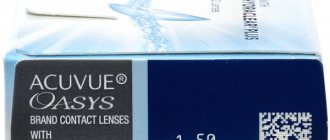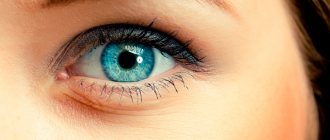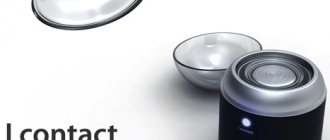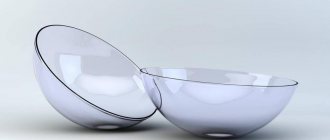Presbyopia, a decrease in the elasticity of the lens, occurs in many people after the age of forty. With this age-related pathology, the lens cannot fully provide the focus of vision, this is expressed in a decrease in the clarity of visibility of objects at different distances. The same problem is observed with an irregularly shaped lens - astigmatism, which can be congenital. Multifocal lenses completely solve the problem of focusing vision at different distances, thanks to which a person can see clearly, as in his youth. Let's look at the types of multifocal lenses and their characteristics, rules for selection and care.
Optical power
Optical power is an indicator of refraction, indicated by a “+” or “-” sign and a number with tenths or hundredths (for example, +3.25 or -1.5). In fact, these are the same diopters that are selected by the ophthalmologist in accordance with the patient’s vision characteristics.
It is worth understanding that the optical power of contact lenses and glasses are two completely different indicators. When selecting lenses, more precise adjustments are made.
If the refraction of the right and left eyes is different, accordingly, the optical power indicators will be different (indicated by: OD for the right eye and OS for the left).
Selecting Contact Lenses
How to choose multifocal lenses, based on what characteristics? Manufacturers offer many models of their products, which include:
- traditional models with a service life of up to six months;
- replaceable daily lenses;
- using for 2-3 weeks.
Products differ in price and degree of comfort in use. However, only an ophthalmologist can select multifocal contact lenses.
The basis for selection is:
- diopter index;
- characteristics of the patient's pupil;
- lifestyle and activity.
After examination by an ophthalmologist, you can go to the store to buy lenses.
Radius of curvature (RC)
The radius of curvature is an indicator characterizing the shape of the back surface of the central part of the contact lens.
In order for optical products to have an ideal fit and be comfortable to wear, their radius of curvature must be as close as possible to the parameters of the eyeball.
BC 8.6 is considered standard, but most manufacturers produce contact correction products with different radii of curvature. This parameter is determined using a special device - an autorefractokeratometer.
Purpose and features of multifocal lenses
The peculiarity of presbyopia is the lack of clear visibility of objects at different distances, as a result of which it is impossible for the patient to choose one pair of glasses for all cases. Presbyopia occurs due to the loss of moisture in the lens and hardening of its structure. The muscle that holds the lens in the eyeball also loses elasticity. As a result, a person sees blurry objects in front of him at a far or near distance, without sharpness of the image.
In the recent past, visibility was corrected using two pairs of glasses—one for far vision and one for near vision. However, scientists have invented an alternative to several pairs of glasses - bipolar lenses. Multifocal lenses have the property of a lens: they quickly change the focus of vision as needed - closer or further.
What is the difference between these optical devices and other lenses? Their difference lies in the design features: the device has several zones that provide visibility of objects of varying degrees of distance. Since these lenses have several areas of visibility, the eyes receive a multivariate image. The principle of MF lenses is based on the brain’s ability to select the desired visualization of an object as needed - closer, further, the middle option.
Multifocal lenses provide:
- peripheral vision;
- panoramic view of the space;
- clear visibility of objects at any distance;
- aesthetics and comfort.
The big advantage is that there is no need for surgical intervention to correct age-related or pathological changes in the lens. Now any elderly person can see clearly even without glasses.
Add
This parameter indicates the diopter power that is required to supplement distance vision in order to see clearly at close range. Addition in optics, as a plus additive for close distance, can be low, medium or high and is indicated in the prescription with the prefix Lo (Low), Med (Medium), Hi (High) or with the exact designation of diopter power: +1; +1.5; +2; +2.50, etc.
Why multifocal lenses?
When compared with glasses, SCLs are significantly superior to them. Patients will need to wear two types of glasses at once to compensate for deficiencies.
Contact optics reduce the load on the eye muscles, they improve visibility and provide clear, non-blurred vision. A special coating improves the clarity of images of objects on the retina. Multifocal products maintain visual acuity at any distance.
While reading, the lower part of the lens is activated; if you need to look into the distance, the upper zone is activated. This is the main difference from conventional contact optics, which allows you to see only at one distance.
They increase the opportunity to engage in active sports. Maintain a high quality of life. This optical aid is an alternative to glasses for presbyopia correction.
The only disadvantage of SCL is the long adaptation period. Getting used to it takes up to 1 week. They are also more expensive than conventional lenses for correcting myopia and farsightedness, which is due to the design features of the optics.
Despite all the advantages of the products, the selection of multifocal or monofocal CL is carried out taking into account the patient’s condition, indications for correction and other conditions (lifestyle, professional activity).
It is worth noting that only 20% of patients refuse to use this optics.
Important points when choosing multifocal lenses
You have received a prescription from your ophthalmologist for multifocal lenses for your eyes, indicating your individual parameters. Can I go shopping? Some patients breathe a sigh of relief and buy lenses that match the parameters in the prescription. And... they remain dissatisfied with the purchase.
Why does this happen? Because the comfort of wearing lenses is also influenced by such points that you should take into account
- wearing mode (daily, flexible, prolonged) in accordance with lifestyle, profession and replacement frequency (daily or every other month);
- quality of optical products: you need to choose certified products from well-known manufacturers in order to eliminate defects and irregularities in the lens production process;
- selection of care products and compliance with the rules of care for a specific pair of lenses in accordance with the manufacturer’s recommendations.
The online contact lens store Ochkov.Net has a large selection of multifocal optical products from manufacturers such as CooperVision, Bausch + Lomb, Alcon. We present a variety of options for all the above parameters: you have the opportunity to select and order a pair that will perfectly suit your eyes. If you have difficulty selecting lenses or care products, you can contact the CDC for specialist advice.
Types of multifocal contact lenses
Let's consider the types of optical instruments, their features and characteristics. The simplest lenses have only two focus modes - far and near. They are called bipolar or bifocal. Lenses with multiple focusing are called multifocal lenses.
Simple bifocal lenses
Bifocal lenses are divided into two types:
- variables;
- concentric.
Variables have two clearly demarcated visibility zones - long-range and short-range. The lower zone of the optics is designed for viewing near objects, the upper part is for observing distant objects. There is a clear dividing line between the zones of visibility: when looking into the distance, you need to direct your eyes up, when looking near you, down.
Concentric lenses are a more advanced type of bifocal optical devices. The visibility zones have a concentric arrangement, and the human brain selects the desired visualization itself.
What is the advantage of bifocal optics? Lens data:
- completely replace wearing glasses;
- provide sharp visualization at any distance;
- do not require an adaptation period.
What are the disadvantages? They are as follows:
- insufficient depth of visualization of the subject;
- discomfort when quickly changing the focus of gaze from a near object to a distant one;
- eye strain when working on a laptop for a long time.
Progressive multifocal lenses
However, the listed types of optics are already considered obsolete - they have been replaced by aspherical lenses with a smooth change in optical power. These devices provide clear visualization even at an intermediate distance (not far and not in front of the eyes).
Advantages:
- provide clear visualization at any distance;
- provide a smooth transition when quickly changing viewing range;
- completely replace progressive glasses.
Some disadvantages:
- the need for adaptation;
- unclear visualization at night;
- high price.
However, expensive progressive multifocal lenses are better than paying for vision correction surgery and using multiple glasses for different purposes.
Artificial lens
The latest developments of scientists include the creation of MF toric intraocular lenses (IOLs) with higher quality optics, which imitate the work of the lens and completely replace it. These devices can be worn by people with cataracts and irregularities in the shape of the lens (astigmatism). The use of these devices after eye surgery prevents complications and further development of pathology: the lenses heal and restore vision.
However, IOLs cannot be called a complete miracle: nothing can completely replace the natural optical mechanism of vision. However, a person gains the ability to see, and not be in complete darkness.
In what cases is implantation of an artificial lens necessary? These include vision defects such as:
- cataract removal;
- refractive lens replacement;
- correction of farsightedness;
- correction of myopia.
Optical lenses are selected individually for each patient, taking into account the specific clinical picture. The material from which the artificial lens is made is completely biologically compatible with human tissue, which eliminates rejection. The IOL has a light-protective property, protecting the retina from UV rays, just like the natural lens.
↑ 5.3. Evaluation of selection results
Symptoms of a flat landing:
- excessive lens mobility
— decentration of the lens, raised lower edge
- discomfort
- unstable vision, worsening after blinking. Symptoms of a steep landing:
- insufficient mobility or lack of mobility
— initial comfort is gradually replaced by the feeling of the lens on the eye
— blurred vision some time after putting on the lens, improvement in visual acuity after blinking
- signs of limbal compression, eye hyperemia
- air bubbles under the lens
How are contact lenses selected?
Consistent and correct selection of contact lenses is carried out in the ophthalmologist's office. This is necessary for two reasons. Firstly, during the examination, the doctor may identify contraindications to wearing contact optics. They are absolute and relative (temporal). Secondly, only with the help of special medical equipment can parameters such as radius of curvature, optical power, etc. be determined. If at least one of these parameters is not taken into account, the lenses will not be able to provide full correction of refractive errors. In addition, they will cause discomfort. Using such ophthalmic products is inconvenient and dangerous.
In some cases, the patient has to undergo a full examination, and not only by an ophthalmologist. This is necessary if you suspect a disease that precludes the possibility of wearing contact optics. As for the ophthalmological examination, it includes the following procedures:
Checking visual acuity. Optical power, expressed in diopters (D), is one of the main parameters. The test is carried out using the tables of Sivtsev, Golovin, and Orlova. Refractometry may also be prescribed, which will provide more detailed information about the refractive error.
Keratometry is a diagnostic procedure by which the curvature of the cornea of the eye is measured. Lenses have such a parameter as the radius of base curvature (BC), which determines the comfort of use of ophthalmic products. It represents the degree of curvature of their surface and must correspond to the curvature of the cornea. If the BC of the lenses is too large, they will shift and tearing will occur. The image will be blurry. When the BC is much smaller than the actual corneal curvature, it is compressed by the ophthalmic product. This is fraught with the development of hypoxic processes. The deviation when choosing a radius should not exceed 0.2 mm.
Biomicroscopy is an ophthalmological examination that allows for examination of the optical media of the eye - the lens and cornea. This procedure is prescribed to exclude diseases that cause clouding of the structures of the refractive system of the eyeball.
Assessing the condition of the tear film . Modern soft lenses are made from hydrogel and silicone hydrogel. They consist of 30-80% water, depending on the specific polymer. When choosing contact optics, it is important to take this parameter into account. Assessing the condition of the tear film will allow you to find out the degree of hydration of the cornea. If your eyes are prone to dryness, it is recommended to wear lenses with a high water content. Also at this stage of the examination, it is determined whether a person can use ophthalmic products in a flexible, prolonged or continuous mode, that is, sleep in them. If an assessment of the condition of the tear shows insufficient moisture of the cornea, contact optics can only be worn during the day.
This is how soft lenses are selected to correct myopia and farsightedness. They are also called simple. Contact optics to compensate for astigmatism and presbyopia are complex. When selecting toric ophthalmic products, it is necessary to determine the axis and optical power of the cylinder. They are designated as Ax and CYL. Ax is the angle of inclination, measured in degrees. CYL is a value characterizing the optical power for astigmatism. It is expressed in diopters. These parameters can only be measured using a computer examination.
Presbyopia is an age-related visual impairment when a person begins to have difficulty seeing small objects at close range. This refractive error requires lenses with a multifocal design. They are equipped with multiple optical centers for vision at different distances. When selecting contact optics to correct presbyopia, tonometry and gonioscopy are performed. These procedures help eliminate glaucoma, which can occur with age-related changes in the eye structures.
Colored lenses are also selected in the same way. Even if they are not equipped with optical power, it is still necessary to undergo an examination. With a ready-made prescription, you can go to an optical salon or place an order in an online store.











